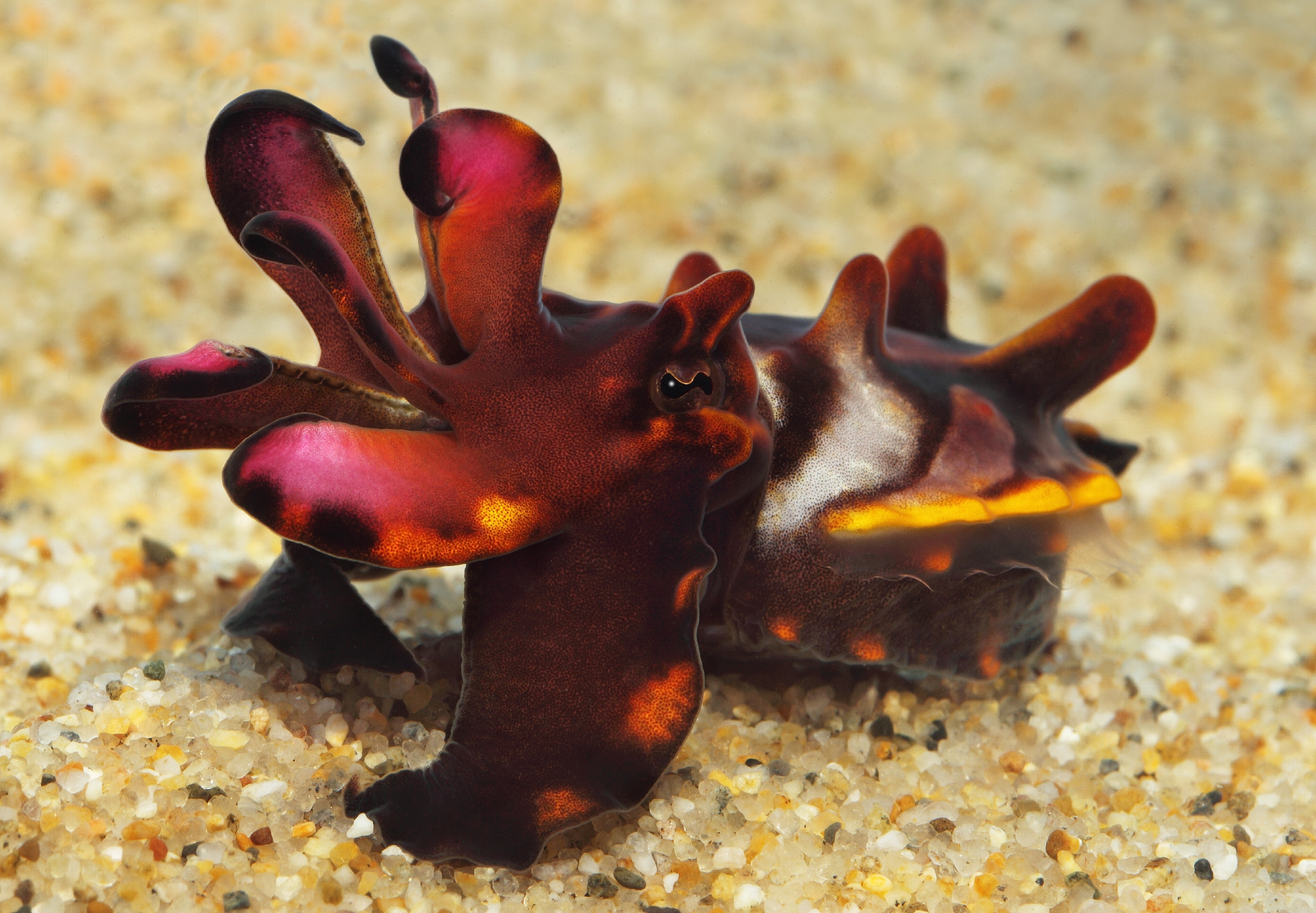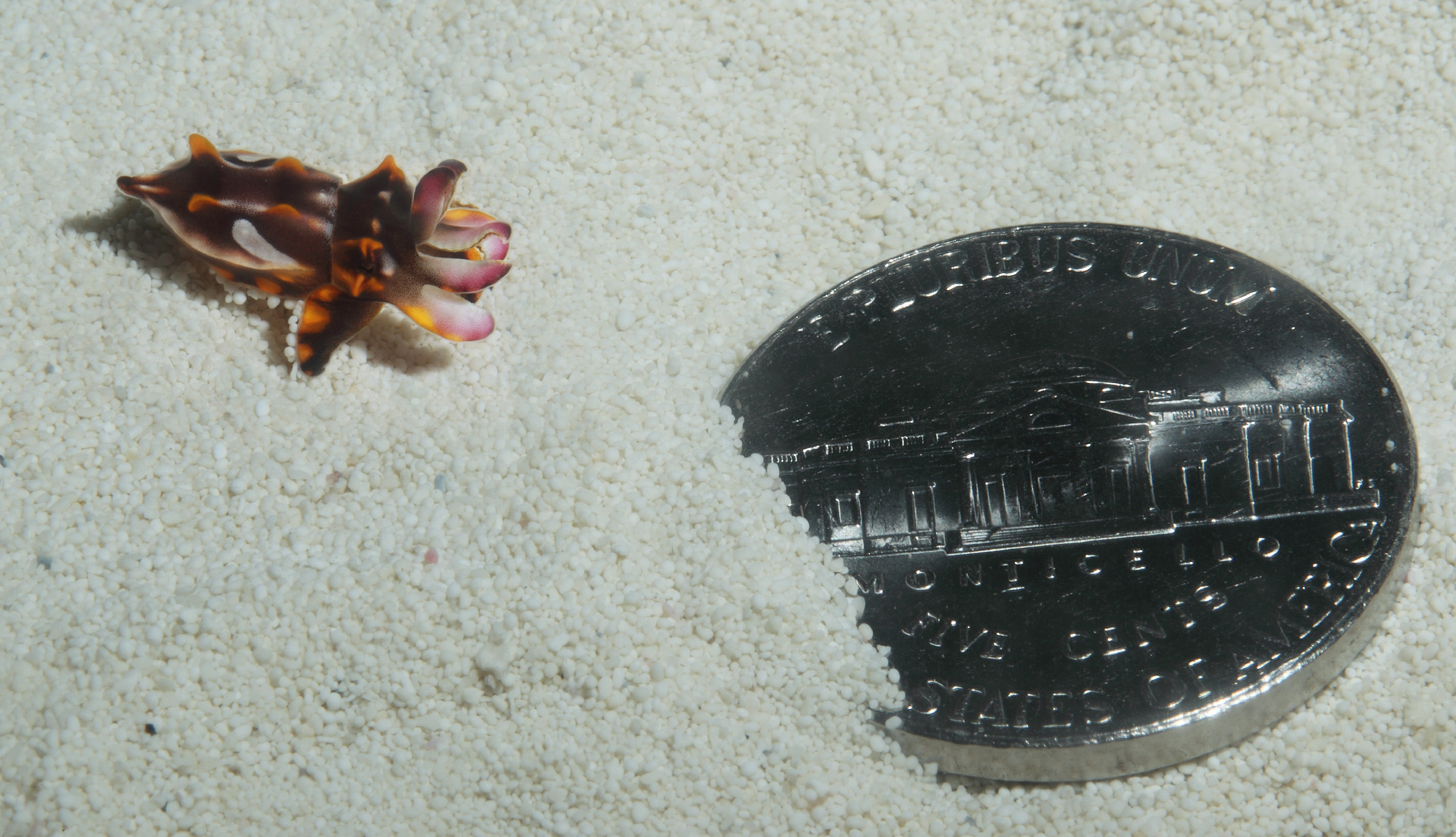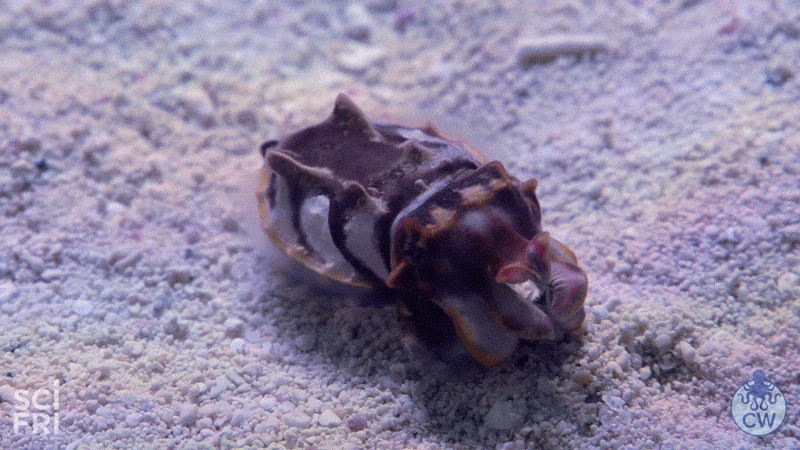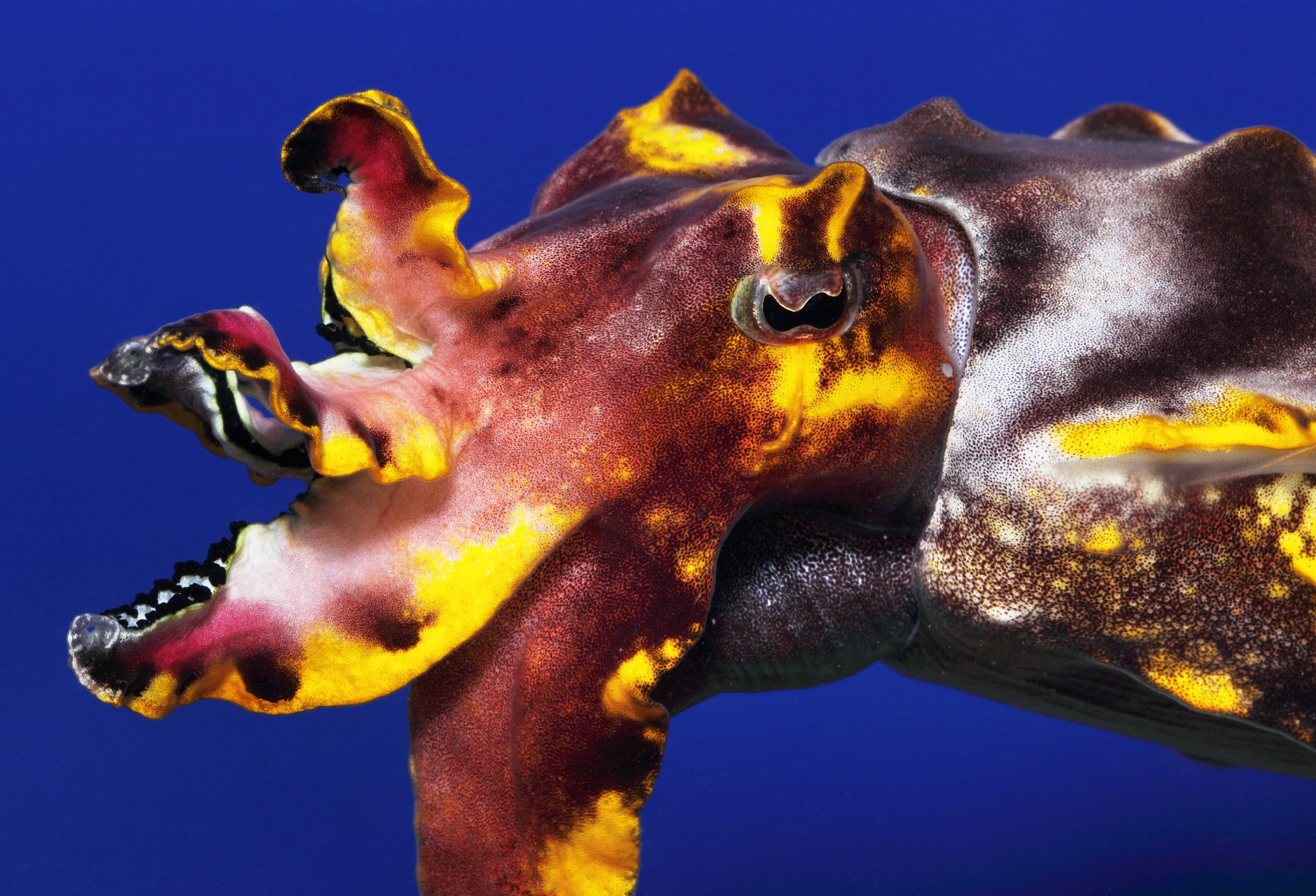This Cuttlefish Dazzles
Internet chatter suggests that the flamboyant cuttlefish—known for ambling along the seafloor and flashing brilliant displays—is toxic. What does the science say?

The flamboyant cuttlefish (Metasepia pfeffer) is one of the species featured in the "Tentacles” exhibition at the Monterey Bay Aquarium. © Monterey Bay Aquarium
Have you ever seen a cuttlefish walk?
If you stop by the Monterey Bay Aquarium’s “Tentacles” exhibit, you might. The aquarium is one of a handful in the country to display flamboyant cuttlefish (Metasepia pfefferi), a diminutive species of cephalopod that often forgoes swimming to crawl, army-style, along the seafloor (or the bottom of a tank).
“They kinda lumber around on four appendages,” says Bret Grasse, who manages the cephalopods in the aquarium’s exhibit. Those appendages include two large arms and portions of the cuttlefish’s mantle, which it extends “to provide what looks like two projected legs,” he explains.
Grasse hypothesizes that the behavior could have something to do with the size of the flamboyant cuttlefish’s cuttlebone, a calcium carbonate structure in the upper portion of the mantle cavity. Cuttlefishes fill chambers in their cuttlebone with air or water to control their buoyancies in order to swim up, or lower down, in the water column.
But M. pfefferi’s cuttlebone “is very small and narrow relative to their body size” (adults grow about three inches, max), says Grasse. Those dimensions might not support much buoyancy, and thus the species might prefer shuffling over surfaces, he suggests.

From a human perspective, the movement is so bizarre that it inspires aquarium observers to analogize. “It’s fun listening to guests, because they’ll watch this type of behavior, and some will say, ‘Oh, it looks like a rhinoceros,’ some will say, ‘Oh, it looks like a frog,’ some will say, ‘Oh, it looks like a dinosaur or an elephant’,” says Grasse. (Watch SciFri’s video about raising cuttlefish, featuring Grasse.)
Flamboyant cuttlefish, which are native to muddy, sandy areas in Indo-Pacific waters, is one of two species currently known to amble along the seafloor. (The other is its cousin from the Pacific, the paintpot cuttlefish, Metasepia tulbergi.)
Aside from that weird walk, M. pfefferi is also unique among cuttlefish for flashing a resplendent display of hues and patterns. “I think of them as sort of like a biological bouquet of flowers,” says Grasse. “They’re just so gorgeous and exotic, and they make such an unbelievably beautiful arrangement of colors together, from reds, pinks, to yellows, to whites, blacks.”
Human observers might also fall under the spell of an undulating series of black bands—what some researchers call a “passing cloud”—that pulses over the cuttlefish’s body. “It’s sorta like they’re pulling black from four different directions,” says Grasse. “And it kind of just melts and disappears as the next band is coming.”
In the wild, flamboyant cuttlefish save their dramatic attire for special occasions—specifically, “to signal some state of alarm or potential response to a predator,” says Roger Hanlon, a senior scientist at the Marine Biological Laboratory in Woods Hole, Massachusetts, who’s done extensive work on cephalopod camouflage and signaling, including two (unpublished) field studies on this species. “Most of the time, in nature, they are so camouflaged, they’re almost impossible to find,” he says.” (For more on cephalopod camouflage, check out this interview with Hanlon.)
When flamboyant cuttlefish put on the ritz, he says, “it’s because camouflage has failed at that point, and they want to startle the predator, make it hesitate, so they can jet away and live for another day.” (The traveling black bands also play a role in courtship.)

Their jazzy body patterning has fueled a myth that flamboyant cuttlefish are venomous. Conspicuous markings in various organisms are often used to advertise toxicity, a strategy known as aposematism. For instance, the blue-lined octopus sports iridescent cobalt markings to warn predators that dining spells death—the species contains a deadly neurotoxin called tetrodotoxin (TTX) that paralyzes victims.
So far, no published studies have investigated whether there’s a bite behind the flamboyant cuttlefish’s bark, but one research team is hoping to soon offer some insight. Grasse has been sending flamboyant cuttlefish from the Monterey Bay Aquarium to researchers at Georgia Southern University and Utah State University, Uintah Basin, who are conducting toxicology studies on both captive-raised and wild specimens, as well as on two other cuttlefish species—the dwarf cuttlefish and the European cuttlefish. (The latter two were intended as controls. Before this research, no cuttlefish species were known to contain toxins.)
Preliminary results have revealed something surprising. Using a sensitive amino assay, the researchers have detected in all three species what they suspect is TTX—at trace amounts. The highest level—100 nanograms—appeared in a wild-caught, male flamboyant cuttlefish. That amount is 10,000 times less than what it would take to kill off a few humans, suggesting that M. pfefferi is “probably not toxic to most vertebrate predators,” says Becky Williams, an assistant professor of biology at Utah State University, Uintah Basin, and one of the researchers on the project.
What’s more, the team has thus far found no reliable pattern to toxin distribution in the flamboyant cuttlefish, or in the other two species. Depending on the individual, TTX showed up in the venom gland, the skin, the reproductive system (for two of the species), and the digestive system.

“So, we’re wondering what the ecological function of tetrodotoxin in the cuttlefish could be, if there is one,” says Williams. Perhaps it’s used as a defense against microorganisms, she muses.
Williams is now developing another type of toxicity test involving chromatography that will help confirm whether or not the substance they found is indeed tetrodotoxin, and not a related poison (more than one analytical method is necessary to prove the presence of TTX). If that test also identifies TTX, the researchers will be closer to confirming that these cuttlefish species indeed contain the neurotoxin.
Meanwhile, Christine Bedore, an assistant professor of biology at Georgia Southern University and another member of the team, has been conducting feeding studies to see if predators reveal any distaste for flamboyant cuttlefish. Thus far, “every predator basically readily eats the flamboyant cuttlefish, and they haven’t had any aversive effects—so they haven’t been sick or anything like that,” says Bedore.
Bedore says that “there’s a lot of work to be done still” on their investigations. But considering the findings thus far, the researchers are wondering if the flamboyant cuttlefish’s bright patterning isn’t so much an advertisement for certain death as it is a neophobic strategy—in other words, says Williams, “just by being weird and unknown and unique, predators might avoid [flamboyant cuttlefish].” What’s certain is that we dazzled humans will keep coming back for more.
With every donation of $8 (for every day of Cephalopod Week), you can sponsor a different illustrated cephalopod. The cephalopod badge along with your first name and city will be a part of our Sea of Supporters!
Julie Leibach is a freelance science journalist and the former managing editor of online content for Science Friday.